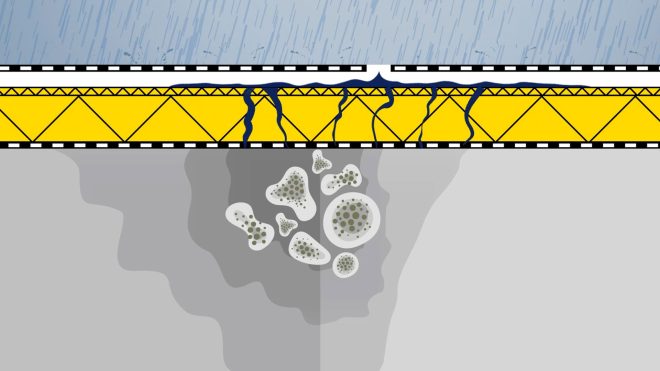Sometimes the smallest things can have a big effect. A tiny hole in the bitumen felt on a flat roof, for example. If it remains undetected, moisture will penetrate the building. By the time it’s noticed, the water damage is already done, and fixing it will entail costly renovation work. To stay one step ahead of moisture Finnish company Vilpe has developed a system that monitors moisture in buildings and dries them as needed.
Vilpe Sense detects even the smallest leaks in the roof and dries the building automatically – thanks to RadiCal EC fan. (Graphic | Vilpe)
Vilpe Sense is the name of the solution and it works as follows: A sensor measures the temperature and relative moisture in the insulation layer, while another sensor records these values for the outside air. A control unit sends the data to the Vilpe cloud, where it is analyzed. If the system detects excessive moisture in the insulation layer, two things happen: The building manager is informed via an app and the fan installed on the roof starts automatically and runs at the required speed until the moisture in the building envelope is back within an acceptable range.

Even a small crack in the roofing felt can cause great damage to flat roofs. That’s what Vilpe Sense is for. (Image | Vilpe)
Dry building envelope = no chance for mold
Veli-Pekka Lahti is Director Research and Development at Vilpe. “In Finland, we have snowy winters, which increases the risk of damage to roofs,” he explains. “There is also a lot of technical equipment installed on them these days, such as solar panels, cooling and ventilation systems. This means that damage to rooftops can happen quickly.”
But Vilpe Sense not only detects damage to existing roofs, it also helps dry out new builds: “During the construction phase, moisture is naturally introduced into the building. Reliable ventilation is essential here, otherwise mold will quickly form,” explains Lahti. “It is difficult to provide good air in living spaces if the building envelope isn’t healthy.” This is why Vilpe Sense is available not only for rooftops, but also for crawlspace ventilation.
Roof ventilation – demand-based and efficient
What is special about the solution is that it works according to demand. An intelligent algorithm controls the speed of the fan installed on the roof. The fan only starts when the sensors in the building envelope detect moisture. But that’s not all: “When temperatures outside are cold, the system automatically reduces the speed of the fan because we don’t want to remove heat from the interiors,” explains Lahti, adding: “On the other hand, when the black roofs heat up a lot in the summer and the moisture evaporates, Vilpe Sense detects this as well and increases the flow rate. Along with the moisture, it then blows the heat out.”
Tests at the Vilpe lab between May and August 2021 found a total of about 692 kWh of excess heat energy dissipated by the system. “This saves energy that would otherwise be used to cool the interiors. So we are operating in a very energy efficient way,” says Lahti.

The system measures relative humidity and temperature in the insulation layer and compares these values with those of the outside air. It independently regulates the rotation speed of the fan and always automatically adjusts it to the demand. (Image | Vilpe)
RadiCal for extreme conditions
The efficiency of the components used was of corresponding importance. Lahti and his team opted for size 190 EC fans from ebm-papst’s RadiCal series. They had already had good experiences with these products in the past. They operate economically and are also extremely robust. An important criterion, as Lahti explains.
In cold outdoor temperatures, the system automatically reduces the speed of the fan. Thus we do not extract heat from the interior.Veli-Pekka Lahti, Director Research and Development at Vilpe
“The climate in Finland is very harsh. We have temperatures ranging from minus 40 to over plus 50 degrees Celsius from the insulation layer. Our products and their components have to withstand this. With ebm-papst fans, we know they are robust enough. We’ve put them through numerous tests and have been using them for many years.” Another plus: They operate very quietly. Since they do their job on the roofs of residential and office buildings, loud fan noises would be unacceptable.
Water damage is a thing of the past
The Vilpe Sense system is now in use on an increasing number of factory and school roofs in Finland. As Lahti explains: “Water damage due to flat roof degradation is much more common than many people think. This is also true for new buildings. In workshops, I often ask if anyone has ever seen a janitor place a bucket under a leak. Usually, half of the participants then put up their hands. With Vilpe Sense, no janitor has to put a bucket down anymore.”



Leave a comment